Guest blogger Helen
A deep-dive into 90s Berlin
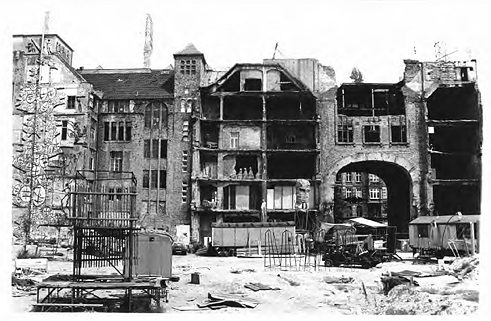
Ever since I heard ‘The Beatles’ sing ‘Komm Gib Mir Deine Hand’ during my high school German studies in Australia, I had been keen to live in Berlin. It seemed so cool and arty, tucked away in what was otherwise the former East. I had even married a Hamburger, which enabled me to work when I arrived, a little late, in January 1991.
Since I’d never been to Berlin before the fall of the Wall, in my writing I voraciously explored how things used to be and how so many iconic Eastern landmarks and places had been re-appropriated into art. In the early 90s I wrote a story on Berlin bars in the former East and it was fascinating.
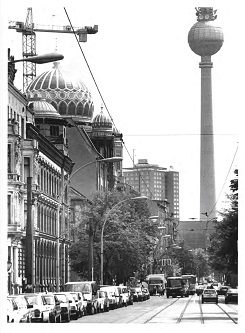 Oranienburgerstrasse in 1991
| © Helen Barlow
Besides operating as a bar, Friseur, a former hairdressing salon with its 50’s conical-shaped dryers, was also a cultural centre, hosting cinema screenings and live performances. Though Oranienburgerstrasse, the focal point of Berlin's Jewish Quarter situated between Friedrichstrasse and Alexanderplatz, was definitely the hub. The most prominent building in the street was the ramshackled alternative art centre, Tacheles, a one-time ornate department store, which was partially destroyed by the Socialist regime. Creatively grafittied by its young inhabitants, it featured a post-apocalyptic cafe with a metal bar and chairs; by night it becomes a music, theatre and cinema venue.
Oranienburgerstrasse in 1991
| © Helen Barlow
Besides operating as a bar, Friseur, a former hairdressing salon with its 50’s conical-shaped dryers, was also a cultural centre, hosting cinema screenings and live performances. Though Oranienburgerstrasse, the focal point of Berlin's Jewish Quarter situated between Friedrichstrasse and Alexanderplatz, was definitely the hub. The most prominent building in the street was the ramshackled alternative art centre, Tacheles, a one-time ornate department store, which was partially destroyed by the Socialist regime. Creatively grafittied by its young inhabitants, it featured a post-apocalyptic cafe with a metal bar and chairs; by night it becomes a music, theatre and cinema venue.
The Trabant became a fascination
The graffiti art continued across the street in Auguststrasse in disused buildings and creative bars. Of course the street is now one of the trendiest in Berlin. My favourite bar at the time, The Verkehr's Beruhigte Ost-Zone (Traffic Free Eastern Zone) specialised in transport memorabilia, with a Trabant car protruding from the wall. The defunct car was adorned with an arrangement of plants; its seats were used as furniture and an old petrol pump graced the bar. The bar's massive clock was bought for a pittance from the Eastern railway, the Reichsbahn.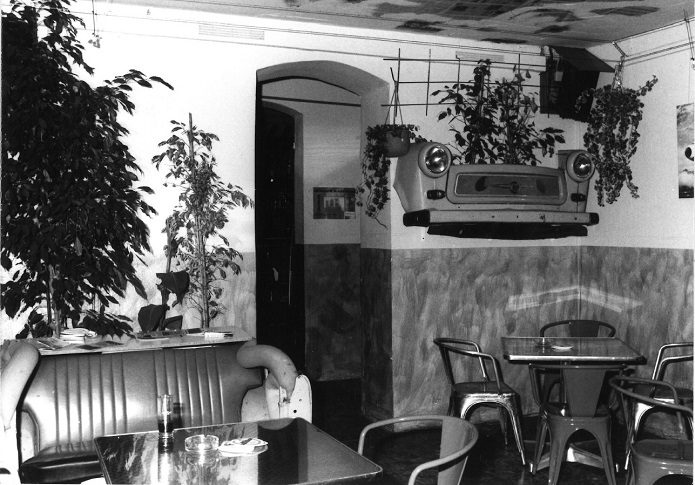 Verkehrsberuhigte Ostzone
| © Helen Barlow
The Trabant became a fascination to me not the least because it was made of plastic and had a tinny two-stroke engine. It was also an emblem of the former East, of the underdog. The 1991 movie Go Trabi Go became a huge commercial hit and spawned a sequel though hardly was a movie for international consumption. I even lived for a spell with friends in a large two-storey house in a north Berlin former Stasi enclave and they had a Trabant so I got to experience the tinny-sounding car, the so-called “spark plug with a roof” at first hand. They also had coal heating, another (smelly) first.
Verkehrsberuhigte Ostzone
| © Helen Barlow
The Trabant became a fascination to me not the least because it was made of plastic and had a tinny two-stroke engine. It was also an emblem of the former East, of the underdog. The 1991 movie Go Trabi Go became a huge commercial hit and spawned a sequel though hardly was a movie for international consumption. I even lived for a spell with friends in a large two-storey house in a north Berlin former Stasi enclave and they had a Trabant so I got to experience the tinny-sounding car, the so-called “spark plug with a roof” at first hand. They also had coal heating, another (smelly) first.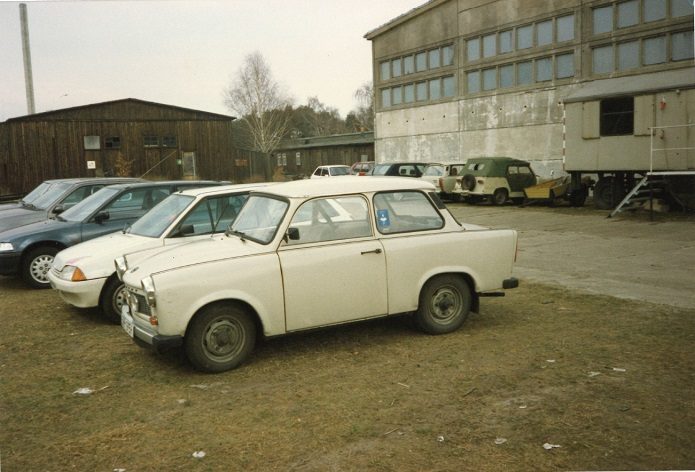 Trabant
| © Helen Barlow
As a qualified schoolteacher I managed to teach English in German in the former East at a school on Schönhauser Allee, the main street in Prenzlauerberg. My skills in grabbing the attention of young’ens came in handy as the East Berlin students, a mix of teenagers and young adults, weren’t particularly interested.
Trabant
| © Helen Barlow
As a qualified schoolteacher I managed to teach English in German in the former East at a school on Schönhauser Allee, the main street in Prenzlauerberg. My skills in grabbing the attention of young’ens came in handy as the East Berlin students, a mix of teenagers and young adults, weren’t particularly interested.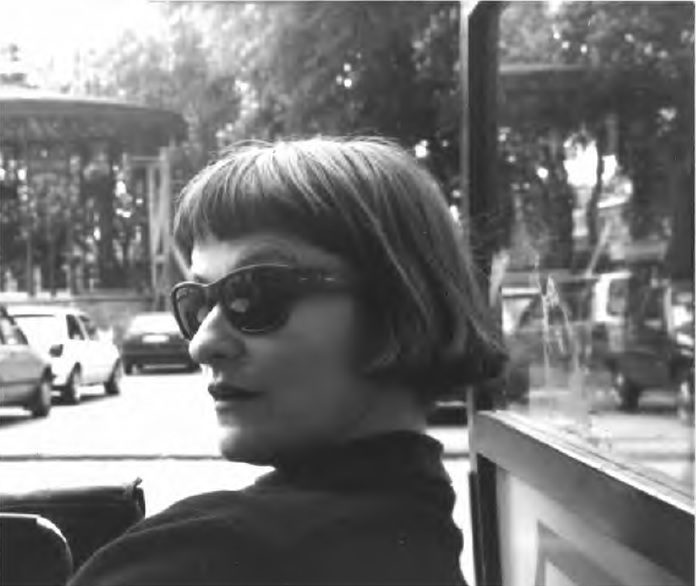 Helen at the time
| © Helen Barlow
At the time telecommunications were so poor in Prenzlauerberg that I invariably lived in the former West, renting apartments cheaply through Mitwohnzentrale (I wrote about that too) when travel-loving West Berliners would go on holiday. Rents were very low and costs for locals were even reduced by a government subsidy to live in the city, which was maintained long after the Wall fell.
Helen at the time
| © Helen Barlow
At the time telecommunications were so poor in Prenzlauerberg that I invariably lived in the former West, renting apartments cheaply through Mitwohnzentrale (I wrote about that too) when travel-loving West Berliners would go on holiday. Rents were very low and costs for locals were even reduced by a government subsidy to live in the city, which was maintained long after the Wall fell.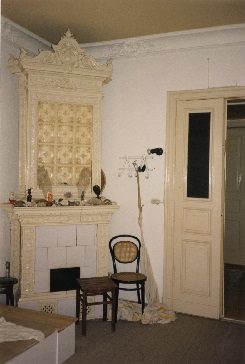 Coal heater
| © Helen Barlow
It was fascinating to move around. I started in Kreuzberg 36 in a studio in Schlesisches Tor, once tucked away in an isolated corner right near the Wall, and now interestingly an alternative area for students and young twentysomethings.
Coal heater
| © Helen Barlow
It was fascinating to move around. I started in Kreuzberg 36 in a studio in Schlesisches Tor, once tucked away in an isolated corner right near the Wall, and now interestingly an alternative area for students and young twentysomethings.
Charlottenburg: too middle class for my youthful sensibility
My brief stay in Charlottenburg was a little dull and too middle class for my youthful sensibility and my friend’s apartment in Nollendorfplatz, where I started out, seemed more my style. Later, I’d cycle to the fax shop there to send off my articles from wherever I was living, as there were only a few fax shops in Berlin. If I was running a deadline I would venture to the seedy midnight environs of the main West Berlin train station where a post office remained open, remarkably.Rather than take public transport I would cycle around on the city’s network of bike paths. In the former East it was like cycling around a museum as the city could not be rebuilt until properties were repatriated to their rightful Jewish owners. Then the city became a kind of building site and it was time to leave.
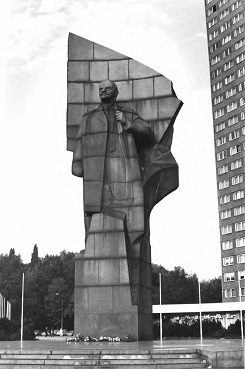 Lenin statue
| © Helen Barlow
In my three years there I also wrote about the enormous Lenin statue, which was demolished at the cost of two million Deutchmarks. (Incredibly Lenin’s 19-metre statue has been exhumed for an exhibition in 2015.) Ugly Eastern monuments were quickly done away with whereas the beauty of Nazi structures like Tempelhof Airport allowed them to remain.
Lenin statue
| © Helen Barlow
In my three years there I also wrote about the enormous Lenin statue, which was demolished at the cost of two million Deutchmarks. (Incredibly Lenin’s 19-metre statue has been exhumed for an exhibition in 2015.) Ugly Eastern monuments were quickly done away with whereas the beauty of Nazi structures like Tempelhof Airport allowed them to remain.The Alexanderplatz Tower, constructed between 1965 and 1969 as a symbol of communist power and of Berlin, has also remained. The brown aesthetic and the faded lacy white curtains made it particularly dowdy. Yet as a lover of a room with a view I gravitated toward its panoramic revolving restaurant. Initially the food was awful though eventually the quality increased, as did the speed of its rotation, which made me a little dizzy.
I began writing for a weekly English-language magazine covering the city’s vibrant culture, especially in the theatre. Given the duplicity of venues for East and West there was a smorgasbord of choices, though as always I veered towards the more avant-garde venues like Hebbel Theater, where I saw Hannah Schygulla, Fassbinder’s muse in Robert Wilson’s magnificent version of Gertrude Stein’s Doctor Faustus Lights the Lights. The government initiative to help fund international artists like Wilson and the Wooster Group, including Willem Dafoe paid its dividends. There was a healthy reciprocity between Berlin and New York when I was there.
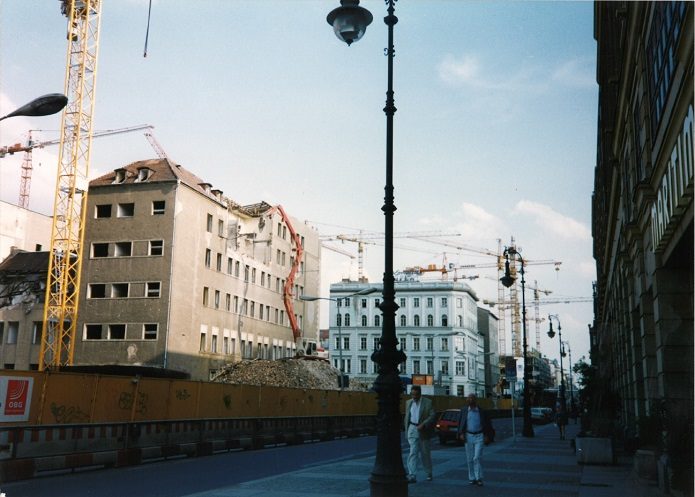 Berlin was a building site
| © Helen Barlow
I wrote a story comparing German and French cultural funding at the time. While both countries ploughed enormous amounts of money into the arts, France was higher end, giving huge amounts to opera, while Germany was grassroots in its approach, helping finance street artists and foreigners. It made life on the street exciting. Anything could happen anywhere. And it did.
Berlin was a building site
| © Helen Barlow
I wrote a story comparing German and French cultural funding at the time. While both countries ploughed enormous amounts of money into the arts, France was higher end, giving huge amounts to opera, while Germany was grassroots in its approach, helping finance street artists and foreigners. It made life on the street exciting. Anything could happen anywhere. And it did.